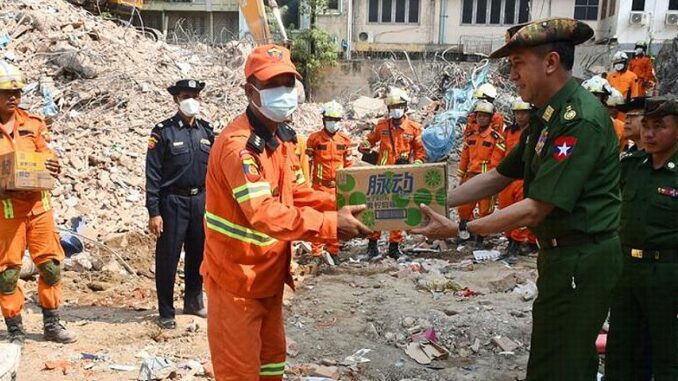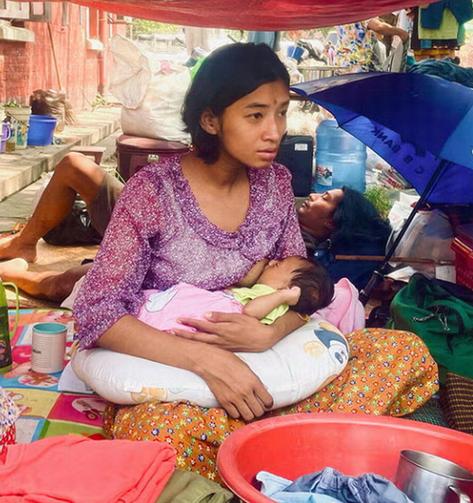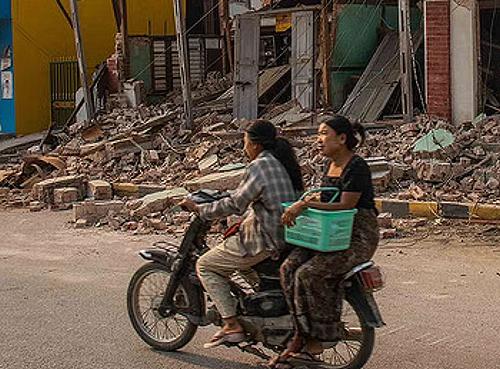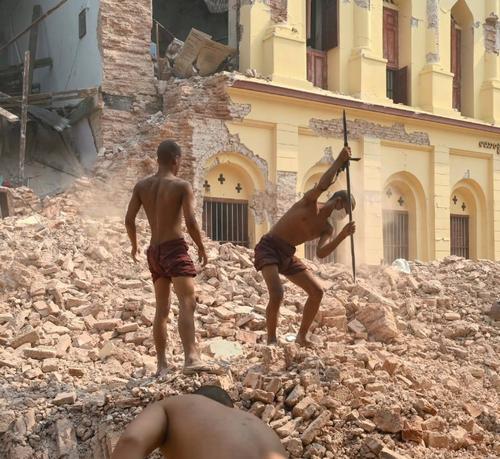
YANGON, Myanmar, April 21, 2025 (ENS) – Military operations continue in Myanmar despite ceasefires declared after the recent 7.7-magnitude earthquake that killed more than 3,700 people, the United Nations human rights office said on Friday.
Australian Minister for Foreign Affairs Senator Penny Wong confirmed this, saying, “There are credible reports that the regime continues to conduct air strikes in earthquake affected areas, exacerbating the suffering of the people of Myanmar and complicating already difficult relief efforts. We condemn these acts and call on the military regime to immediately cease military operations and allow full humanitarian access to affected areas.”
At the same time the military government is passing out aid boxes to some earthquake responders, as shown in the image above, issued by Myanmar’s Commander-in-Chief of Defence Services, CINCDS, on April 21.
The earthquake struck central Myanmar three weeks ago, on March 28, killing at least 3,700 people, injuring 4,800 others and leaving 129 people still missing.
The UN Office for the Coordination of Humanitarian Affairs, OCHA, is warning that the final death toll will be much higher due to underreporting and challenges in data collection and verification.
More than 140 aftershocks, some as severe as magnitude 5.9, have rocked the region since the initial quake, worsening the psychological trauma, particularly on children and displaced families, according to a bulletin issued Friday by OCHA.
“Frequent strong aftershocks continue to shake central Myanmar almost daily, increasing fear and uncertainty,” OCHA said, explaining that many families still sleep outdoors, exposed to the elements and the risk of disease and venomous insect and snake bites.
The aftershocks have also disrupted response efforts. There are fears that the aftershocks may persist for months following such a major earthquake, given that Myanmar is in a tectonically active region, OCHA warned.
Unseasonably heavy rains with strong winds, thunder, lightning, and hail overwhelmed Myanmar earlier this month, complicating efforts to respond to the disaster.
As Myanmar grapples with the aftermath of the devastating 7.7-magnitude earthquake, its already fragile healthcare system, already battered by conflict and poverty, is buckling under the intense strain, and thousands of people remain in crisis weeks later.

More than 190 health facilities have been damaged and essential medicines are running out, impeding antenatal and postnatal care as well as access to emergency obstetric and neonatal services.
More than 4.3 million people urgently need clean water and sanitation, as the earthquakes severely damaged water systems, collapsed over 42,000 latrines and caused widespread power outages that have halted water pumping in many areas.
Damage to water systems has forced residents to rely on unsafe sources, heightening the risk of waterborne illnesses.
Malnutrition is also a growing concern, particularly among children, as food insecurity worsens and nutrition support becomes harder to deliver.
Education infrastructure has been hard hit. With the new school year set to begin in June, hundreds of damaged classrooms must be cleared, repaired or rebuilt, and clean water, toilets and basic hygiene facilities restored before students can safely return.
The earthquake struck during central Myanmar’s dry season, one of the country’s most important agricultural belts. The hardest-hit regions are responsible for a third of the country’s cereal production and four-fifths of its corn output, the UN reports.
Damage to farmland and supporting infrastructure now threatens food production just as the monsoon planting season approaches.
“Livelihoods have been upended due to widespread damage to farmland, essential infrastructure and other income-generating businesses,” OCHA said.
Worst Risks Endanger Women and Girls
Women and girls are exposed to what the UN is calling “a convergence of threats,” with the crisis compounding existing vulnerabilities and disrupting access to protection and health services.

According to the UN sexual and reproductive health agency, the United Nations Population Fund, UNFPA, more than 10 million women and girls were already in urgent need of assistance before the quake. Now, displacement, overcrowded shelters and damaged health infrastructure have heightened risks of gender-based violence, while also limiting access to essential maternal and reproductive health services.
UNFPA Myanmar head Jaime Nadal Roig says that humanitarians are working to ease the situation in Mandalay and Sagaing, where the quakes hit hardest. Humanitarian agencies and local responders have reached over 240,000 people with food, medical supplies and essential items, as of April 18.
Over 100 metric tonnes of medical supplies have been delivered, and mobile health teams are providing trauma care and psychosocial support in the worst-hit areas.
UNFPA and its partners have scaled up services, prioritizing support for pregnant women, adolescent girls and persons with disabilities. They have distributed over 4,000 dignity kits and clean delivery kits in Mandalay and Sagaing, and are setting up safe spaces for women and girls as key entry points for protection, psychosocial support and referrals.
Despite these efforts, the scale and urgency of the disaster demand far greater action, resources and access, OCHA is urging.
Alongside partners, the United Nations launched a $275 million appeal last week to reach an additional 1.1 million people with urgent aid.
This request is on top of the $1.1 billion humanitarian response plan launched in December 2024 to help 5.5 million of the most vulnerable people suffering the effects of conflict and long-standing hardship.
In neighboring Thailand, the earthquake was felt across 63 of the country’s 77 provinces.
Reports of 23 fatalities and 36 injuries came in from Thailand, with the capital city, Bangkok, the most severely affected. Damage occurred in 18 Thai provinces, mostly in the north.
In Australia, Senator Wong, Minister for Foreign Affairs, and Minister for International Development and the Pacific Pat Conroy MP announced in early April that Australia will contribute additional support for the quake-affected people of Myanmar. This support builds on Australia’s initial $2 million contribution to the International Committee for the Red Cross, ICRC.
Australia’s additional support includes:
- $3.5 million to Australian nongovernmental organizations and their local partners with a focus on food, water and sanitation and emergency health and education, and $500,000 contribution to the Emergency Action Alliance appeal.
- $3 million for emergency relief supplies and to support the efforts of the ASEAN Coordinating Centre for Humanitarian Assistance on Disaster Management.
A rapid response team has also been mobilized through Australia Assists, to help coordinate disaster relief efforts on the ground.

The governments of Australia, India, Japan, and the United States, collectively known as The Quad, said, “We welcome recent commitments to temporary, partial ceasefires and call on all parties to implement, extend and broaden these measures, to provide a safe and conducive environment to facilitate timely delivery of life-saving humanitarian assistance throughout Myanmar.”
The Quad partners have so far committed humanitarian assistance estimated at a combined value of over US$20 million. Through funding and bilateral efforts, the four allies are delivering relief supplies, deploying emergency medical teams, and supporting humanitarian partners working in Myanmar to provide care for those affected by the earthquake.
The Quad’s Humanitarian Assistance and Disaster Relief Partnership has established a coordination group that is collaborating on disaster management with other partners, including the ASEAN Coordinating Centre for Humanitarian Assistance.
Myanmar’s Earthquake History
This region has a history of significant seismicity, with six earthquakes of greater than 7.0 magnitude occurring within about 250 kilometers (150 miles) of the March 28 quakes since 1900, according to the U.S. Geological Survey, which maintains a global earthquake database.
The surface rupture generated by the March 28 earthquakes has been estimated to span 550 kilometers (342 miles) in length. With a rupture extending from north of Mandalay to south of Myanmar’s capital, Nay Pyi Taw, it is one of the longest documented strike-slip fault-induced surface ruptures on record.
Preliminary analyses of the rupture by other scientists found that, in addition to being long, the March 28 quake was remarkably fast, suggesting it may have been a rare “supershear” earthquake, NASA said. In these events, the slip along the fault moves faster than the seismic waves it produces, which can concentrate seismic energy ahead of the rupture. NASA suggests that this effect may amplify a quake’s destructive forces and might be part of the reason why the March 28 quake caused so much damage so far from the epicenter.
Featured image: Relief workers receive aid boxes at a site in the city of Mandalay where buildings were damaged by the March 28, 2025 earthquake, Mandalay, Myanmar. (Photo issued by Myanmar’s Commander-in-Chief of Defence Services, CINCDS, on April 21, 2025)
